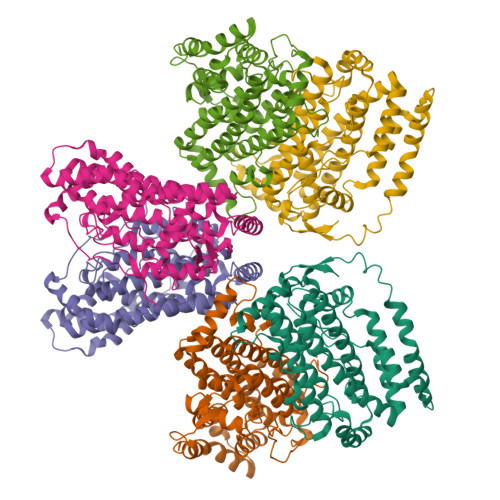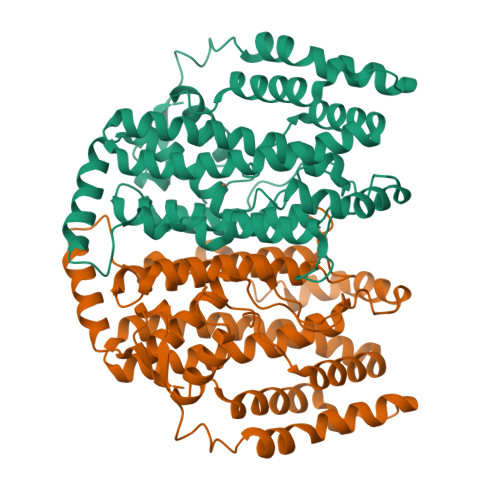Azide and Acetate Complexes plus two iron-depleted Crystal Structures of the Di-iron Enzyme delta9 Stearoyl-ACP Desaturase-Implications for Oxygen Activation and Catalytic Intermediates
Moche, M., Shanklin, J., Ghoshal, A., Lindqvist, Y.(2003) J Biological Chem 278: 25072-25080
- PubMed: 12704186
- DOI: https://doi.org/10.1074/jbc.M301662200
- Primary Citation of Related Structures:
1OQ4, 1OQ7, 1OQ9, 1OQB - PubMed Abstract:
Delta9 stearoyl-acyl carrier protein (ACP) desaturase is a mu-oxo-bridged di-iron enzyme, which belongs to the structural class I of large helix bundle proteins and that catalyzes the NADPH and O2-dependent formation of a cis-double bond in stearoyl-ACP. The crystal structures of complexes with azide and acetate, respectively, as well as the apoand single-iron forms of Delta9 stearoyl-ACP desaturase from Ricinus communis have been determined. In the azide complex, the ligand forms a mu-1,3-bridge between the two iron ions in the active site, replacing a loosely bound water molecule. The structure of the acetate complex is similar, with acetate bridging the di-iron center in the same orientation with respect to the di-iron center. However, in this complex, the iron ligand Glu196 has changed its coordination mode from bidentate to monodentate, the first crystallographic observation of a carboxylate shift in Delta9 stearoyl-ACP desaturase. The two complexes are proposed to mimic a mu-1,2 peroxo intermediate present during catalytic turnover. There are striking structural similarities between the di-iron center in the Delta9 stearoyl-ACP desaturase-azide complex and in the reduced rubrerythrin-azide complex. This suggests that Delta9 stearoyl-ACP desaturase might catalyze the formation of water from exogenous hydrogen peroxide at a low rate. From the similarity in iron center structure, we propose that the mu-oxo-bridge in oxidized desaturase is bound to the di-iron center as in rubrerythrin and not as reported for the R2 subunit of ribonucleotide reductase and the hydroxylase subunit of methane monooxygenase. The crystal structure of the one-iron depleted desaturase species demonstrates that the affinities for the two iron ions comprising the di-iron center are not equivalent, Fe1 being the higher affinity site and Fe2 being the lower affinity site.
Organizational Affiliation:
Department of Medical Biochemistry and Biophysics, Karolinska Institutet, Stockholm S-171 77, Sweden.



















